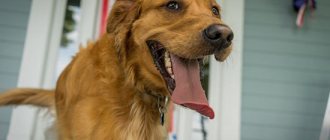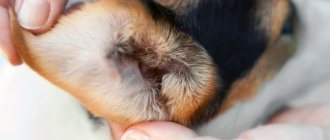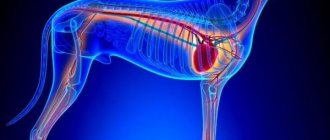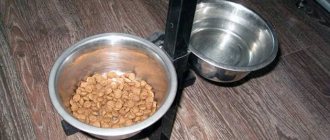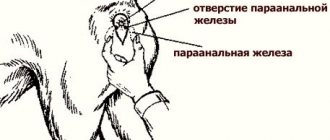Reasons why a dog may spin around itself
This behavior is not always a deviation or a sign of a disease. For example, if a dog is spinning behind its tail, it is young and playful, then, most likely, this is just entertainment, so it gives an outlet for its energy. For many dogs, “circling in circles” is a residual phenomenon of survival instincts in the wild, while for others it is a sign of gastrointestinal diseases, stress or mechanical injuries.
To understand whether you should worry, pay attention to:
- pet's age;
- the presence of other symptoms of disease;
- changes in usual lifestyle.
Expert opinion
Kuzmenko Olga Olegovna
Information about the expert
Ask a Question
If the habit of spinning around its axis has already appeared in an adult dog, analyze what has changed in his life. Perhaps food, place of residence, family composition.
Before bedtime
Many dogs spin around themselves before lying down, and this habit has been going on for a long time. Dogs were not always domestic dogs; they had to survive in the wild. 360 degree rotations made it possible to check the safety of the area and whether there was an enemy nearby.
The second aspect, dating back to the same times, is the need to prepare the bed. There were no comfortable beds before, and animals had to make their own bed. With their paws they smoothed the grass or crushed the snow, scared away insects, and made a rounded “bed”. Instinctively, it seems that in the “nest” it is more difficult for the predator to notice the prey.
Games
One of the favorite games of young dogs is catching their tail. She is safe and very fun to watch. Puppies can have fun in this way until they are 4-5 years old. Sometimes this indicates insufficient physical activity. There are no pathologies if:
- While running, the pet is in a playful mood.
- There are no symptoms of disease.
- Whirling occurs after some event: swimming, a walk, the owner returning home.
If you see that your pet really wants to play, give him some time. It’s better for him to throw out energy in a peaceful direction than for you to find a torn pillow or slippers later.
Discomfort
If a dog is spinning around and whining, then it is experiencing discomfort. There may be several reasons for its appearance. The first is pain or itching, feeling unwell. Check:
- Do you have a fever (dry, warm nose);
- mouth (mucous membranes should not be bright red);
- stool (is there any disorder or constipation);
- how does the dog eat, has his appetite changed;
- is there any redness on the skin?
A common cause of physiological discomfort is lack of space (leash, cramped enclosure). Remember that no matter what purpose you keep your pet, it definitely needs to exercise a lot and have comfortable living conditions.
If a dog bites its tail and spins around, then the discomfort is caused by problems with the gastrointestinal tract; it may be painful or difficult for it to go to the toilet.
Neurological problems
Dogs are emotional creatures and what may seem normal to a person becomes very stressful for an animal. To suppress fears and obsessive thoughts, the dog begins to perform repetitive actions, this is called obsessive-compulsive disorder. It is diagnosed in 2 out of 100 dogs.
Its causes are:
- Loneliness, isolation from people and other pets.
- Aggression, physical impact from owners.
- Inconsistency in the manner of parenting (you cannot first allow something and then unexpectedly punish for similar behavior).
- Enclosed space (regardless of whether the dog is in an apartment or in a booth, he needs to be given freedom periodically).
Doberman Pinschers, Labradors, Bull Terriers, and German Shepherds are prone to this disorder.
Diseases, injuries
Repetitive actions are different. Dogs that have lived on the street often develop the habit of circling and licking their paws. This complicates diagnosing the problem, since the limbs in this case turn out to be completely healthy. Their “treatment” is an acquired instinct of the dog.
But you still need to pay attention to such symptoms, since they often signal pathologies such as:
- Mechanical injuries, bruises of the paws, back of the body. It may be painful for the animal to sit or lie down.
- Infection with helminths causes itching in the anus, so the dog spins around on its butt, bites its tail, and behaves restlessly. Signs of the presence of parasites are increased appetite without weight gain, rapid weight loss, and the presence of blood streaks in the stool.
- Infectious diseases (viral, bacterial) provoke pain. The dog will whine, hide, and refuse to eat. His anxiety may manifest itself as running in circles.
- Allergic reactions cause severe itching at the site of irritation. The animal will try to get rid of it by licking and gnawing out the disease. Additional symptoms of dermatitis are peeling, redness of the skin, and partial hair loss.
- Loss of coordination is caused by traumatic brain injuries. The pet simply cannot sit or lie down the first time.
- A similar problem is caused by visual impairment. The animal may freeze in place, spin, or bump into walls or other obstacles.
- Often an old dog spins around in one place due to problems with joints and poor coordination of movements.
- Hepatoencephalopathy. The disease is accompanied by neuralgic disorders and occurs due to liver dysfunction. The condition is serious, characterized by vomiting, diarrhea (including blood), epileptic seizures, severe agitation or apathy.
If the dog is spinning around itself, determine the disease. Pay attention to how your pet is feeling, its behavior and other symptoms. Consult your veterinarian as each condition requires an individual treatment regimen.
When should you worry about your pet's health?
Having considered all the reasons, we understand that a pet circling around itself can be either a completely harmless phenomenon or a sign of a serious illness. You should be wary if:
- This behavior has not previously been observed in an adult dog;
- the dog is restless, worried, whining;
- There are other symptoms of pathologies.
Expert opinion
Kuzmenko Olga Olegovna
Information about the expert
Ask a Question
Do not determine the cause yourself, consult a doctor. Don't believe the misconception that if a dog bites its tail and spins, it must have worms. Be aware of other possible reasons for the behavior.
Folk signs
The puppy whines when left alone: how to wean it off
Dogs are sensitive creatures. They can not only sense the mood of the owner, but also predict the future. Many centuries ago, people believed that the howling of a dog meant misfortune in the house: illness or death. If a whining dog was looking at a house, it meant that there would be a fire or theft there in the future. Howling at the moon signaled great trouble.
For your information! The ancestors were most afraid when a dog whined while holding its head straight, because this foreshadowed war or famine.
How to fix the problem?
The method for solving a problem directly depends on its nature:
- You can do nothing about playfulness at a young age; it’s good if you can provide your pet with more active games and long walks. Teaching commands helps, they shift attention from unwanted actions.
- If the dog is experiencing stress or physiological discomfort, it must be addressed. For short scares, such as fireworks, form positive associations. Long-term behavioral therapy should be carried out under the supervision of an animal psychologist. It is based on establishing a connection between the stimulus and affection, play, and encouragement.
- For severe obsessive-compulsive disorder, medications are prescribed.
When diseases or injuries are detected, the veterinarian prescribes treatment. Antihistamines for allergies, anthelmintics for parasite infections, hepatoprotectors, antiviral and antibacterial agents in cases of serious pathologies and infections.
Physical and intellectual stress
Every dog needs a certain level of exercise, physical and intellectual. Activity needs vary from breed to breed. However, there are general recommendations that are suitable for almost every animal.
- The dog needs at least half an hour of aerobic exercise (running, swimming). Sufficient physical activity allows the animal to relax and calm down, distracting it from factors that cause anxiety and stress. It is especially important not to neglect training with your dog on days when he may be faced with a frightening situation.
- Active games in the fresh air allow the animal to get rid of excess energy and get into a good mood.
- Frequently changing the route of daily walks gives the dog the opportunity to get acquainted with new smells, objects and sounds and diversifies its life.
- Social contacts with other dogs (games) without a leash, the opportunity to enjoy long runs and the company of active animals improves the dog’s quality of life, reduces anxiety, and allows it to adapt to interactions with unfamiliar animals and people.
To successfully treat your dog and ensure a decent quality of life, it is advisable to contact a professional trainer. It is highly recommended that an inexperienced owner take a training course under the supervision of a specialist.
What can't you do?
If your dog has OCD, you shouldn’t scold him; punishing him will only make the situation worse. Encouraging the animal to calm down is also not recommended; the pet will take this as permission to continue this behavior. The best option is to contact a specialist; the situation can be corrected by switching attention and practicing commands.
In case of illnesses or injuries, it is also impossible to scold an animal for spinning or whining. The dog will experience both physiological pain and stress, this will complicate the course of the disease.
Remember that you are responsible not only for the dog’s behavior, but also for its health and mood. They will be good, with constant care and comfortable living conditions. Be attentive to alarming symptoms and don’t worry about trifles.
Changing the situation
First, it is recommended to identify the situations that provoke your dog’s obsessive actions. Having identified them, they must be avoided, this will significantly reduce the level of anxiety and stress in the animal. However, it is impossible to avoid situations that frustrate the dog, such as a thunderstorm, a smell that frightens the animal, or a certain type of noise. Special training as part of behavior therapy will help the animal learn to react differently to a situation that cannot be prevented. Thanks to training, the level of anxiety will significantly decrease, which will lead to stabilization of your pet’s psychological state.



